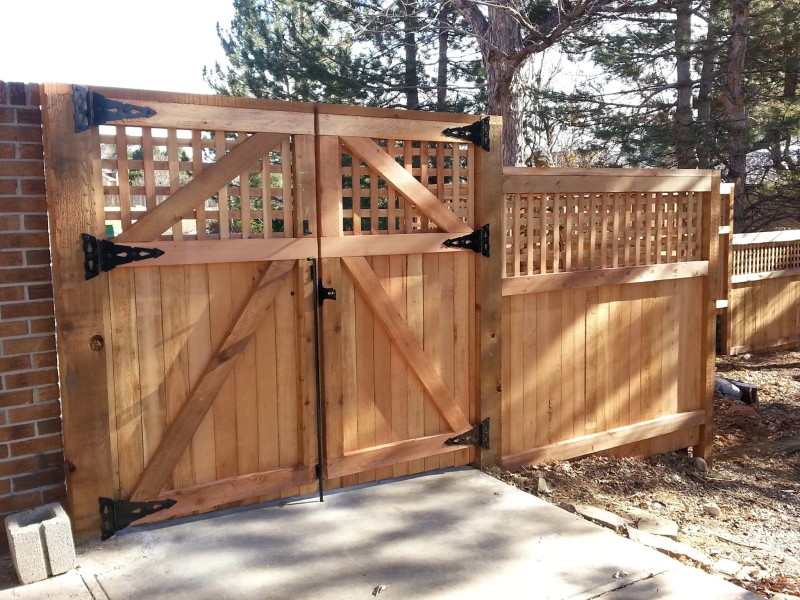All Categories
Featured
Whether your fencing is made of timber, chain, metal, or vinyl link, adhering to some basic maintenance pointers can aid guarantee its longevity and capability. Below's just how you can maintain your fence in great problem year-round.
![]()
Wooden Fences: Use a pressure washer with a low-pressure setting to delicately remove dust and debris. For stubborn discolorations or mold and mildew, scrub the impacted locations with a combination of water and moderate detergent or a vinegar remedy. Plastic Fencings: Vinyl fencings are easy to tidy with soapy water and a soft brush. Avoid unpleasant materials, as they can scrape the surface. Metal Fences: Aluminum or wrought iron fences can be cleaned up with a soft fabric or sponge taken in soapy water. For rust, utilize a corrosion remover especially made for steel surface areas. Chain Web Link Fencings: A straightforward laundry with a tube or a pressure washing machine can remove particles from chain link fences. You may likewise require to trim any kind of plants expanding near the fence. 2. Look for Damages and Make Repairs Promptly. For wood fencings, check for deteriorating or bending of the slabs. Steel fencings may create rust spots, while vinyl fences can become weak or broken in extreme climate conditions.
If you find any kind of issues, make repairs as quickly as feasible. Tiny repairs, such as changing a couple of loose or broken boards, can stop larger, much more expensive repairs down the line. For rust, you can sand it down and use a coat of rust-resistant paint to extend the life of the steel.
If your wood fencing is repainted, inspect for peeling paint and touch up any places to keep its look and secure the timber from the aspects.
Additionally, be mindful of dropped leaves or branches, especially in fall, as they can trigger and gather moisture build-up, resulting in decomposing or rusting, specifically in wood and metal fencings.
![]()
![]()
Conclusion. Normal maintenance is key to keeping your fencing looking great and working effectively for many years. Whether you have a wooden, steel, chain, or plastic web link fencing, following these ideas will aid you preserve its elegance and stamina.
- Normal Cleansing. Cleaning your fencing consistently is one of the easiest and most effective ways to maintain it in top form. In time, dust, mold, algae, and mold can build up, specifically on wooden fences. These contaminants not only affect the appearance of your fence yet can likewise degrade the material if left neglected. To clean your fence:

Wooden Fences: Use a pressure washer with a low-pressure setting to delicately remove dust and debris. For stubborn discolorations or mold and mildew, scrub the impacted locations with a combination of water and moderate detergent or a vinegar remedy. Plastic Fencings: Vinyl fencings are easy to tidy with soapy water and a soft brush. Avoid unpleasant materials, as they can scrape the surface. Metal Fences: Aluminum or wrought iron fences can be cleaned up with a soft fabric or sponge taken in soapy water. For rust, utilize a corrosion remover especially made for steel surface areas. Chain Web Link Fencings: A straightforward laundry with a tube or a pressure washing machine can remove particles from chain link fences. You may likewise require to trim any kind of plants expanding near the fence. 2. Look for Damages and Make Repairs Promptly. For wood fencings, check for deteriorating or bending of the slabs. Steel fencings may create rust spots, while vinyl fences can become weak or broken in extreme climate conditions.
If you find any kind of issues, make repairs as quickly as feasible. Tiny repairs, such as changing a couple of loose or broken boards, can stop larger, much more expensive repairs down the line. For rust, you can sand it down and use a coat of rust-resistant paint to extend the life of the steel.
- Treat Wooden Fences for Climate Protection. Wooden fences are specifically at risk to weather damage. To prevent this, treat your wooden fencing with a safety sealer or stain.
If your wood fencing is repainted, inspect for peeling paint and touch up any places to keep its look and secure the timber from the aspects.
- Maintain Greenery in Examine. Plants and bushes expanding near or on your fencing can create considerable damages. Roots from neighboring trees or shrubs might get into the space around fencing blog posts, destabilizing them.
Additionally, be mindful of dropped leaves or branches, especially in fall, as they can trigger and gather moisture build-up, resulting in decomposing or rusting, specifically in wood and metal fencings.

- Reapply Protective Coatings for Steel Fences. Metal fences, such as wrought iron or light weight aluminum, can last for numerous years with the correct treatment. Reapply protective finishes, such as rust-resistant paint, every couple of years to keep your fence looking excellent and safeguard it from the elements.
- Keep the Fencing's Structural Integrity. For wooden fences, evaluate the base of the blog posts for indications of rot. For metal and vinyl fencings, check the posts for any type of flexing or damages.

Conclusion. Normal maintenance is key to keeping your fencing looking great and working effectively for many years. Whether you have a wooden, steel, chain, or plastic web link fencing, following these ideas will aid you preserve its elegance and stamina.
Latest Posts
Specialist Residential Roof Covering Solutions You Can Trust Fund
Published May 23, 25
1 min read
Expert Residential Roof Covering Solutions You Can Count On
Published May 23, 25
1 min read
Explore Reduce Expenses on Car Maintenance with Montclare Auto Repair’s Special Deals
Published May 23, 25
1 min read
More
Latest Posts
Specialist Residential Roof Covering Solutions You Can Trust Fund
Published May 23, 25
1 min read
Expert Residential Roof Covering Solutions You Can Count On
Published May 23, 25
1 min read
Explore Reduce Expenses on Car Maintenance with Montclare Auto Repair’s Special Deals
Published May 23, 25
1 min read